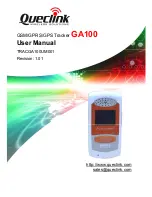
Reporting Protocol (PROT)
The AT240 supports various reporting protocols (data packet formats). Protocols used by other
devices are implemented for compatibility with existing systems. To take advantage of the full
AT240 feature set, the specific AT240 protocols “M” or “V” are recommended.
Documentation for each of these protocols is available on request from Astra Telematics, please
email
for a copy.
<prot>
Reporting protocol
0
Fixed packet protocol “A”
Legacy - not for new implementations
1
Fixed packet protocol “C”
Legacy - not for new implementations
2
Fixed packet protocol “G” Basic version
Legacy - not for new implementations
3
Fixed packet protocol “G” Extra version
Legacy - not for new implementations
4
Fixed packet protocol “H”
Legacy - not for new implementations
5
Fixed packet protocol “F”
Legacy - not for new implementations
6
Fixed packet protocol “K”
Legacy - not for new implementations
7
Fixed packet protocol “L”
Legacy - not for new implementations
8
Fixed packet protocol “M”
RECOMMENDED (AT240 w/o CANBus data)
9
Fixed packet protocol “N”
AT240 with FMS data
10
Fixed packet protocol “P”
Carrier Transicold Refrigerator data
11
Fixed packet protocol “R”
AT240 with OBD data
12
Fixed packet protocol “S”
As “M” but with Enhanced ADC resolution
13
Fixed packet protocol “T”
As “M” but with ECON gritter status data
14
Fixed packet protocol “V”
RECOMMENDED (AT240 with FMS or OBD)
Pass Through Data Mode (PTDM)
Pass through data mode enable. Set this parameter to 1 to enable Pass Through Data Mode.
Note that when Pass Through Data Mode is enabled, debug and NMEA output are suppressed
from the AT240 serial port (DBUG and NMEA set to zero). Please refer to the appropriate
Application Note for further details.
Alarm Phone Number (ALRM)
This is the delivery destination for alarm text messages sent via SMS. These are typically sent to
a GSM handset (mobile telephone). The number should be entered in international format (e.g.
+447979123456). Alarm text messages are sent for external power loss and low external power
(supply input less than 11.5V).
Roaming Enable (ROAM)
This parameter can be used to disable network roaming, as a means of controlling GSM network
running costs. A value of zero will disable network roaming. The ROAM parameter can also be
used to allow reporting at a reduced rate when roaming. A value of greater than 1 will cause the
reporting intervals (DIST, HEAD, STIM and JTIM) to be extended by the specified value of ROAM.
For example, when ROAM is set to 2, all of the reporting intervals are doubled, so that the
reporting rate will be approximately half as much as when using the home GSM network
operator. The default setting for ROAM is 1, which enables normal reporting on either home or
roaming networks.
SMS Monthly Usage Limit (SMSL)
This parameter can be used to control SMS costs by setting a monthly limit on the number of
SMS which may be sent from the AT240. A value of zero will disable the Monthly SMS Limit
feature.
Distance Reporting Interval (DIST)
Distance based reporting interval in metres. This feature can be disabled by setting Minimum
Distance Moved to zero.












































